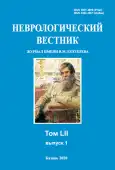Physicians who use substances: what does it look like and what to do about it?
- Authors: Sivolap Y.P.1, Savchenkov V.A.1, Yanushkevich M.V.1, Pushin P.V.1
-
Affiliations:
- I.M. Sechenov First Moscow State Medical University
- Issue: Vol LII, No 1 (2020)
- Pages: 9-13
- Section: Editorial
- URL: https://journals.rcsi.science/1027-4898/article/view/19060
- DOI: https://doi.org/10.17816/nb19060
- ID: 19060
Cite item
Full Text
Abstract
Substance use disorders in physicians is a serious problem of the medical community and public health. The prevalence of substance use disorders depends on gender, age and medical specialty. The substance abuse impairs physical and mental health of physicians and affects the quality of patient care. Treatment of chemically addicted physicians involves the use of conventional therapeutic approaches adopted in addiction medicine, but requires compliance with certain special principles.
Full Text
##article.viewOnOriginalSite##About the authors
Yury P. Sivolap
I.M. Sechenov First Moscow State Medical University
Author for correspondence.
Email: yura-sivolap@yandex.ru
ORCID iD: 0000-0002-4494-149X
Prof., Md, Phd, doc. Med. Sci.
Russian Federation, 8-2, Trubetskaya street, Moscow, 119992Vladimir A. Savchenkov
I.M. Sechenov First Moscow State Medical University
Email: yura-sivolap@yandex.ru
Russian Federation, 8-2, Trubetskaya street, Moscow, 119992
Maksim V. Yanushkevich
I.M. Sechenov First Moscow State Medical University
Email: yura-sivolap@yandex.ru
Russian Federation, 8-2, Trubetskaya street, Moscow, 119992
Pavel V. Pushin
I.M. Sechenov First Moscow State Medical University
Email: yura-sivolap@yandex.ru
Russian Federation, 8-2, Trubetskaya street, Moscow, 119992
References
- Braquehais M.D., Lusilla P., Bel M.J. et al. Dual diagnosis among physicians: a clinical perspective. J. Dual. Diagn. 2014; 10 (3): 148–155. doi: 10.1080/15504263.2014.929331.
- Seppala M.D., Berge K.H. The addicted physician. A rational response to an irrational disease. Minn. Med. 2010; 93 (2): 46–49.
- Saunders J.B., Conigrave K.M., Latt N.C. et al. Addiction medicine. (Oxford specialist handbooks.) Second ed. Oxford: Oxford University Press. 2016; 677 p.
- Latt N., Conigrave K., Saunders J.B. et al. Addiction medicine. (Oxford specialist handbooks.) Oxford: Oxford University Press. 2009; 459 c.
- Schifferdecker M., Schmidt R., Loevenich A., Krahl A. Drug dependence among physicians. Z. Arztl. Fortbild. (Jena). 1996; 90 (4): 295–300.
- Vayr F., Herin F., Jullian B. et al. Barriers to seeking help for physicians with substance use disorder: a review. Drug-Alcohol-Depend, 2019; 199: 116–121; doi: 10.1016/j.drugalcdep. 2019.04.004.
- Bryson E.O. The opioid epidemic and the current prevalence of substance use disorder in anesthesiologists. Curr. Opin. Anaesthesiol. 2018; 31 (3): 388–392. doi: 10.1097/ACO.0000000000000589.
- Garcia-Guasch R., Roigé J., Padrós J. Substance abuse in anaesthetists. Curr. Opin. Anaesthesiol. 2012; 25 (2): 204–249. doi: 10.1097/ACO.0b013e32834ef91b.
- Maier C., Iwunna J., Soukup J., Scherbaum N. Addicted anaesthetists. Anasthesiol. Intens. Med. Not Fallmed Schmerzther. 2010; 45 (10): 648–654; quiz 655. doi: 10.1055/s-0030-1267531.
- McAuliffe P.F., Gold M.S., Bajpai L. et al. Second-hand exposure to aerosolized intravenous anesthetics propofol and fentanyl may cause sensitization and subsequent opiate addiction among anesthesiologists and surgeons. Med. Hypotheses. 2006; 66 (5): 874–882. doi: 10.1016/j.mehy.2005.10.030.
- Oreskovich M.R., Shanafelt T., Dyrbye L.N. et al. The prevalence of substance use disorders in American physicians. Am. J. Addict. 2015; 24 (1): 30–38. doi: 10.1111/ajad.12173.
- Sørensen J.K., Pedersen A.F., Bruun N.H. et al. Alcohol and drug use among Danish physicians. A nationwide cross-sectional study in 2014. Dan. Med. J. 2015; 62 (9): piiA5132.
- Pedersen A.F., Sørensen J.K., Bruun N.H. et al. Risky alcohol use in Danish physicians: associated with alexithymia and burnout? Drug Alcohol. Depend. 2016; 160: 119–126. doi: 10.1016/j.drugalcdep.2015.12.038.
- Pförringer D., Mayer R., Meisinger C. et al. Health, risk behaviour and consumption of addictive substances among physicians — results of an online survey. J. Occup. Med. Toxicol. 2018; 13: 27. doi: 10.1186/s12995-018-0208-7.
- Ohida N., Otsuka Y., Kaneita Y. et al. Factors related to alcohol consumption among Japanese physicians. Asia Pac. J. Public Health. 2018; 30 (3): 296–306. doi: 10.1177/1010539518754539.
- Wunsch M.J., Knisely J.S., Cropsey K.L. et al. Women physicians and addiction. J. Addict. Dis. 2007; 26 (2): 35–43. doi: 10.1300/J069v26n02_05.
- Loevenich A., Schmidt R., Schifferdecker M. Physicians as patients — on the problem of the mentally ill physician. Fortschr. Neurol. Psychiatr. 1996; 64 (9): 344–352. doi: 10.1055/s-2007-996576.
- Toney-Butler T.J., Siela D. Recognizing alcohol and drug impairment in the workplace in Florida. StatPearls (Internet). Treasure Island (FL): StatPearls Publishing. 2019; 2019 Jul 30. https://www.ncbi.nlm.nih.gov/pubmed/?term=Recognizing+Alcohol+and+Drug+Impairment+in+the+Workplace+in+Florida (access date: 10.01.2020).
- Baldisseri M.R. Impaired healthcare professional. Crit. Care Med. 2007; 35 (suppl. 2): S106– S116. doi: 10.1097/01.CCM.0000252918.87746.96.
- Kumar P., Basu D. Substance abuse by medical students and doctors. J. Indian Med. Assoc. 2000; 98 (8): 447–452.
- Wright E.L., McGuiness T., Moneyham L.D. et al. Opioid abuse among nurse anesthetists and anesthesiologists. AANA J. 2012; 80 (2): 120–128.
Supplementary files






